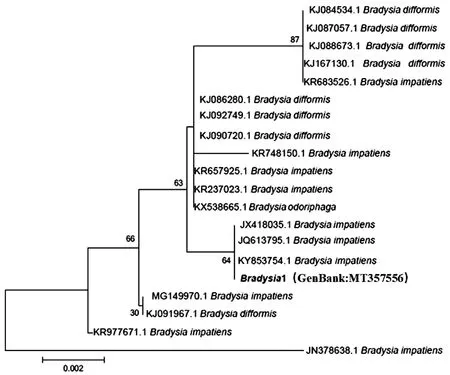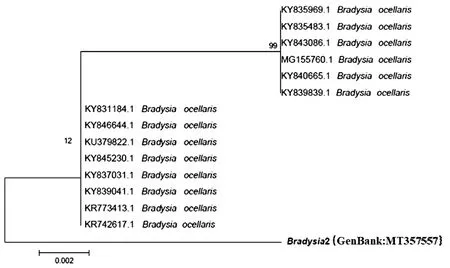First record of Bradysia spp. (Diptera: Sciaroidea)infesting Anoectochilus roxburghii (Wall.)Lindl in China
CHEN Si-Qi, YU Jin-Yong, HASSAN Babar, HUANG Jun-Hao, XU Yi-Juan *
(1. South China Agricultural University, Department of Entomology, Guangzhou 510640, China; 2. Hebei Normal University of Science & Technology, College of Agronomy and Biotechnology, Qinhuangdao 066600, Hebei Province, China; 3. Zhejiang A & F University, Department of Forest Protection, Hangzhou 311300, China)
Abstract: This paper presents the first report of Bradysia spp. i.e. Bradysia impatiens (Johannsen 1912)and Bradysia ocellaris (Comstock, 1882)infesting Anoectochilus roxburghii (Wall.)Lindl (Orchidaceae), a widely used traditional medicinal herb in China. This discovery reminds entomologists and farmers to be aware of these potential pests on A. roxburghii and other Orchidaceae flowers with great economic importance.
Key words: Molecular identification; greenhouse crops; medicinal herb; new pest
Anoectochilusroxburghii(Wall.)Lindl (Orchidaceae)is a widely used traditional medicinal herb in China (Luoetal., 2018)and also valued in many other countries, such as India, Bangladesh, Nepal, Myanmar, Bhutan, Thailand and Japan, and popular as a ‘jewel orchid’ due to its beautiful purplish-red to greenish-brown leaves with golden-red reticulations (Bhattacharjee, 2013).A.roxburghiihas been widely used for medicinal, culinary, and ornamental purposes and is a rich source of vitamins, polysaccharides, alkaloids and organic acids (Yeetal., 2017).
Bradysiaspecies (Sciaridae: Diptera)are notorious pests of many greenhouse crops and plants (Shinetal.,2013). Some species of this genus have become the most devastating pests in greenhouses and cause severe economic losses in China (Shenetal., 2008). Here, this study is the first to document the presence ofBradysiaspecies infestingA.roxburghiiin the world. Therefore, more detailed investigation ofBradysiapests onA.roxburghiiand other Orchidaceae flowers with great economic importance is deserved.
1 Materials and Methods
1.1 Insects collection
Bradysiaadults were collected by mouth aspirator inA.roxburghiiseedling nursery in Longmen, Huizhou City, Guangdong Province, China by the authors. Roots ofA.roxburghiiinfested by larvae were taken to the laboratory (Department of Entomology, South China Agricultural University, Guangzhou)and reared to adulthood.B.impatiensandB.ocellarisadults were identified based on their morphological characteristics by Junhao Huang (Zhejiang A & F University, Hangzhou).
1.2 Molecular identification
Genome DNA was isolated by usinga DNeasy? Blood and Tissue Kit (Qiagen, Inc., Hilden, Germany). The mtCO1 universal primers LCO1490 and HCO2198 were used for PCR amplification. The TaKaRa TaqTM(with Mg2+-free buffer)system (Takara Biomedical Technology Co., Ltd., Beijing, China)was used for PCR amplification. The following PCR cycles were used for mtCO1 amplification: Incubation at 95℃ for 5 min, followed by 35 cycles of 95℃ for 30 s, 45℃ for 40 s and 72℃ for 50 s, and a final extension at 72℃ for 10 min. PCR products were electrophoresed in 1.2% agarose to verify the integrity of the fragments. Then, these samples were sent to Sangon Biotech (Shanghai City, China)for sequencing.
We analyzed 658 bp of the mtCO1 sequence. Each sequence was compared with the mitochondrial genomes of other species using the NCBI BLAST (http://blast.ncbi.nlm.nih.gov/Blast.cgi).A phylogenetic tree was generated with MEGA 5.0 software (Tamuraetal., 2011).
2 Results
The individuals from the two samples,Bradysia1 andBradysia2, were molecularly identified using their mtCO1 sequences. The sequence analysis results showed that the mtCO1 sequence ofBradysia1 was 100% identical to that ofBradysiaimpatiens(GenBank: JX418035.1)within 96% query coverage (Fig.1). The mtCO1 sequence ofBradysia2 was 98.62% identical to that ofBradysiaocellaris(GenBank: KY846644.1)with 97% query coverage (Fig.2). Thus, theBradysiaspp. that infestedA.roxburghii(Wall.)Lindl in Huizhou, China wereB.impatiensandB.ocellaris.

Fig.1 Phylogenetic tree based on mtCO1 sequence data of Bradysia 1

Fig.2 Phylogenetic tree based on mtCO1 sequence data of Bradysia 2
3 Conclusion and Discussion
The individuals from the two samples collected by mouth aspirator inA.roxburghii,Bradysia1 andBradysia2 were molecularly identified asBradysiaimpatiensandBradysiaocellaris.B.impatienswidely distributed in China and damages mushrooms, shallot, spring onion, lily, garlic, cucumber, melon and several other greenhouse crops and causes severe economic losses in China and worldwide (Gouetal., 2015).B.ocellariswas first recorded from a glasshouse in Tasmania in 1992 (Menzeletal., 2003), and no detailed records or research on this species can be found from China. In recent years, research onBradysiahas focused on the study of its morphological, biological, genetic and molecular characteristics and biochemical control (Zhangetal., 2008; Hurleyetal., 2010; Shinetal., 2013).A.roxburghiiis a very important medicinal herb in China. It is commercially cultivated in Fujian Province. However, cultivation of, as well as research on,A.roxburghiiis relatively scarce in Guangdong Province. In recent years, local pharmaceutical companies and some farmers have introducedA.roxburghiifrom Fujian Province. Nevertheless, due to some biotic and abiotic factors, the survival rate ofA.roxburghiiin this province is relatively low (Linetal., 2018).
Therefore, this analysis provides a useful tool for the detection and identification ofBradysiasp. found on this herb to develop pest control technology and to solve the technical bottlenecks impactingA.roxburghiiproduction in Guangdong (Lian, 2013). Our results also alert entomologists and farmers to be aware of these potential pests onA.roxburghiiand other Orchidaceae flowers with great economic importance.

